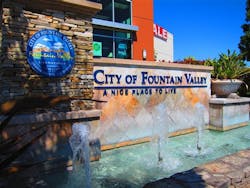California City Beats Water Reduction Goal With Smart Water Network
Dried-up reservoirs, cracked dirt and empty swimming pools are just a few of the visual reminders of the ongoing California drought. But what most people do not see is water providers such as Mark Sprague, utilities manager for the City of Fountain Valley, Calif., working tirelessly to keep the water running.
The State of California asked all residents to help reduce the state’s water usage by 500 billion gal in order to combat the drought. For residents like Sprague, this means reducing individual daily usage by 15 to 20 gal.
Sprague gulps down a glass of cold water while pondering the drought. Then it hits him: His individual water conservation goal is equal to about 100 of these glasses of water per day.
“Our citizens were eager to help, but overwhelmed with where to start,” he said. “First, we had to figure out where the water was going and share this information with them. Second, we had to stop all leaks and unnecessary usage.”
Fountain Valley created a master plan long before individual developments sprouted up. This small municipality, home to more 55,000 residents, could not have foreseen the historic drought that it faces. In fact, the name Fountain Valley refers to the high water table the area once boasted. With those levels now lower, the community needed a long-term solution to the water crisis. It even decided to turn off its iconic fountain to save water and set a good example for residents.
Plans Without Data
The first challenge was to identify where water was being used. This would help Fountain Valley’s water division and its customers spot leaks and develop ways to reduce consumption. Leaders such as Sprague knew that water was going down the drain, but how much and where remained a mystery.
Fountain Valley implemented water restrictions such as conservation rebates and irrigation restrictions to encourage residents to save water. But without a tool to track these measures, they could not see if customers were following water mandates.
For example, in Orange County (where Fountain Valley is located), approximately 50 to 60% of household water is used outdoors for activities such as watering lawns. The city wanted to restrict watering to certain days of the week but needed a tool to confirm customers were following the guidelines.
The city decided to turn off its iconic fountain to save water and set a good example for residents.
Putting Power in the Hands of Residents
Fountain Valley deployed a Sensus smart water network, including the FlexNet communication system and iPERL residential and OMNI commercial meters. Together, the city and its customers got a lot smarter about where they could cut back on water use and proactively identify leaks.
The FlexNet system is a long-range radio network that provides a scalable and reliable communications infrastructure that enables smart water networks and smart cities. Sensus OMNI commercial meters offer sustained precision over time, and Sensus iPERL water meters capture the lowest flows and maintain measurement accuracy for their 20-year lifetimes.
Exceeding the 20% Reduction Goal
Through a combination of leadership, citizen commitment and Sensus technology, Fountain Valley exceeded its reduction goal, ultimately cutting usage by 23%.
“Sensus solutions helped us to monitor drought conservation regulations and exceed our goal of a 20% drop in water use,” Sprague said. “The smart water network alerts us to high volume users and allows us to work closely with those customers to find ways to use water more efficiently.”
Restrictions and conservation rebates are some of the ways residents are encouraged to save water. Those efforts continue to reach new levels by using smart water technology. Now Fountain Valley can:
- See where and how much water is being used;
- Proactively share data with residents and businesses; and
- Empower residents to work together to conserve water and prevent leaks.
Sprague and his team also receive a dozen or more leak alerts each week. With this data, they are able to address minor issues through customer calls and letters. When alerted to a major leak, staff immediately heads to the location to address the issue. Within a few months, Fountain Valley stopped two major leaks that threatened to waste water and ruin a home’s foundation.
“Before deploying Sensus technology, it was difficult to determine how much water we were losing each year and when customers were not following restrictions,” Sprague said. “Today, we know almost immediately where water is going and can educate our customers who are watering at incorrect times.”
Building a Better Future
Meeting the water usage reduction mandate is just the beginning. The city recently deployed Customer Connect, an online portal that encourages residents to sign up, monitor their usage and even detect leaks on their own. This is just one example of how Fountain Valley will use technology to conserve for the long term.
The water scarcity issue in California is an ongoing challenge, but with the improved data accuracy and applications provided through the Sensus smart water network, Fountain Valley is on the path to creating a better future for its community.
